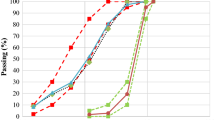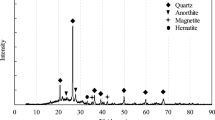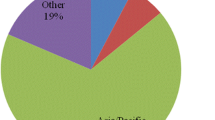Abstract
Concrete compressive strength decreases significantly with decreasing density and therefore, there are few examples of structural grade concretes with densities below 1,600 kg/m3. Here we show the development of structural lightweight aggregate concrete in the 1,200–1,600 kg/m3 density range. Compressive strengths of up to 36 MPa are obtained at 28 days. By using fibers, mixes with flexural strengths of up to 7 MPa and high ductility in flexure are obtained at 28 days. These results are significantly better than those in existing literature at comparable densities. Compressive strength of lightweight concrete depends on both paste and aggregate properties, while the flexural strength depends mostly on the volume fraction of fibers used.







Similar content being viewed by others
References
Alduaij J, Alshaleh K, Haque MN, Ellaithy K (1999) Lightweight concrete in hot coastal areas. Cem Concr Compos 21(5–6):453–458. doi:10.1016/S0958-9465(99)00035-9
Ansari F, Zhang Z, Szary P, and Maher A (2002) Effects of synthetic air entraining agents on compressive strength of Portland cement concrete-Mechanism of interaction and remediation strategy. Federal Highway Administration Report FHWA-NJ-2002-025
Balaguru P, Dipsia MG (1993) Properties of fiber reinforced high-strength semilightweight concrete. ACI Mater J 90(5):399–405
Bhatty JI, Reid KJ (1989) Moderate strength concrete from lightweight sludge ash aggregates. Int J Cem Compos Lightweight Concr 11(3):179–187. doi:10.1016/0262-5075(89)90091-2
Bogas JA, Gomes A, Pereira MFC (2012) Self-compacting lightweight concrete produced with expanded clay aggregate. Constr Build Mater 35:1013–1022. doi:10.1016/j.conbuildmat.2012.04.111
Bogas JA, Gomes A (2013) Compressive behavior and failure modes of structural lightweight aggregate concrete—characterization and strength prediction. Mater Des 46:832–841. doi:10.1016/j.matdes.2012.11.004
Bogas JA, Gomes MG, Gomes A (2013) Compressive strength evaluation of structural lightweight concrete by non-destructive ultrasonic pulse velocity method. Ultrasonics 53(5):962–972. doi:10.1016/j.ultras.2012.12.012
Bremner TW, Holm TA (1986) Elastic compatibility and the behavior of concrete. ACI J. Proc. 83(2):244–250. doi:10.14359/10422
Bremner TW, Holm TA (1995) High performance lightweight concrete—a review. ACI SP 154:1–20. doi:10.14359/947
Campione G, Miraglia N, Papia M (2001) Mechanical properties of steel fibre reinforced concrete with pumice stone or expanded lightweight clay aggregates. Mater Struct 34(4):201–210. doi:10.1007/BF02480589
Chandra S, Berntsson L (2002) Lightweight aggregate concrete. William Andrew Publishing, New York
Chen B, Liu J (2004) Properties of lightweight expanded polystyrene concrete reinforced with steel fiber. Cem Concr Res 34(7):1259–1263. doi:10.1016/j.cemconres.2003.12.014
Chen B, Liu J (2005) Contribution of fibers on the properties of the high-strength lightweight concrete having good workability. Cem Concr Res 35(5):913–917. doi:10.1016/j.cemconres.2004.07.035
Chi JM, Huang R, Yang CC, Chang JJ (2003) Effect of aggregate properties on the strength and stiffness of lightweight concrete. Cem Concr Compos 25(2):197–205. doi:10.1016/S0958-9465(02)00020-3
Demirboğa R, Gül R (2003) The effects of expanded perlite aggregate, silica fume and fly ash on the thermal conductivity of lightweight concrete. Cem Concr Res 33(5):723–727. doi:10.1016/S0008-8846(02)01032-3
De Weerdt K, Haha MB, Le Saout G, Kjellsen KO, Justnes H, Lothenbach B (2011) Hydration mechanisms of ternary Portland cements containing limestone powder and fly ash. Cem Concr Res 41(3):279–291. doi:10.1016/j.cemconres.2010.11.014
Düzgün OA, Gül R, Aydin AC (2005) Effect of steel fibers on the mechanical properties of natural lightweight aggregate concrete. Mater Lett 59(27):3357–3363. doi:10.1016/j.matlet.2005.05.071
Gao J, Sun W, Morino K (1997) Mechanical properties of steel fiber-reinforced, high-strength, lightweight concrete. Cem Concr Compos 19(4):307–313. doi:10.1016/S0958-9465(97)00023-1
Glenn GM, Miller RM, Orts WJ (1998) Moderate strength lightweight concrete from organic aquagel mixtures. Ind Crop Prod 8(2):123–132. doi:10.1016/S0926-6690(97)10016-4
Green S, Brooke N, and McSaveney L (2010) Pumice aggregates for structural lightweight and internally cured concretes. Research Report for Industrial Processors Limited (INPRO)
Hassanpour M, Shafigh P, Bin Mahmud H (2012) Lightweight aggregate concrete fiber reinforcement—a review. Constr Build Mater 37:452–461. doi:10.1016/j.conbuildmat.2012.07.071
Kayali O, Haque MN, Zhu B (2003) Some characteristics of high strength fiber reinforced lightweight aggregate concrete. Cem Concr Compos 25(2):207–313. doi:10.1016/S0958-9465(02)00016-1
Ke Y, Beaucour AL, Ortola S, Dumontet H, Cabrillac R (2009) Influence of volume fraction and characteristics of lightweight aggregates on the mechanical properties of concrete. Constr Build Mater 23(8):2821–2828. doi:10.1016/j.conbuildmat.2009.02.038
Kim HK, Jeon JH, Lee HK (2012) Workability, and mechanical, acoustic and thermal properties of lightweight aggregate concrete with a high volume of entrained air. Constr Build Mater 29:193–200. doi:10.1016/j.conbuildmat.2011.08.067
Le Roy R, Parant E, Boulay C (2005) Taking into account the inclusions’ size in lightweight concrete compressive strength prediction. Cem Concr Res 35(4):770–775. doi:10.1016/j.cemconres.2004.06.002
Libre NA, Shekarchi M, Mahoutian M, Soroushian P (2011) Mechanical properties of fiber reinforced lightweight aggregate concrete made with natural pumice. Constr Build Mater 25(5):2458–2464. doi:10.1016/j.conbuildmat.2010.11.058
Litsomboon T, Nimityongskul P, Anwar N (2009) Development of lightweight aggregate concrete containing pulverized fly ash and bottom ash. Adv Concr Str. 400–402:379–385. doi:10.4028/www.scientific.net/KEM.400-402.379
Lo TY, Cui HZ, Li ZG (2004) Influence of aggregate pre-wetting and fly ash on mechanical properties of lightweight concrete. Waste Manag 24(4):333–338. doi:10.1016/j.wasman.2003.06.003
Miao B, Chern J-C, Yang C-A (2003) Influences of fiber content on properties of self-compacting steel fiber reinforced concrete. J Chin Inst Eng 26(4):523–530
Mounanga P, Khokhar MIA, El Hachem R, Loukili A (2011) Improvement of the early-age reactivity of fly ash and blast furnace slag cementitious systems using limestone filler. Mater Struct 44(2):437–453. doi:10.1617/s11527-010-9637-1
Muethel RW (1995) Investigation of the air content of plastic vs. hardened concrete. Michigan Department of Transportation Research Report R-1332
Mun KJ (2007) Development and tests of lightweight aggregate using sewage sludge for nonstructural concrete. Constr Build Mater 21(7):1583–1588
Nehdi M (2001) Ternary and quaternary cements for sustainable development. Concr Int 23(4):34–42
Poppe A-M, De Schutter G (2005) Cement hydration in the presence of high filler contents. Cem Concr Res 35(12):2290–2299. doi:10.1016/j.cemconres.2005.03.008
Reiter L (2013) Mechanical aspects of smart dynamic casting. M.S. Thesis, ETH Zürich
Sadrmomtazi A, Sobhani J, Mirgozar MA, Najimi M (2012) Properties of multi-strength grade EPS concrete containing silica fume and rice husk ash. Constr Build Mater 35:211–219. doi:10.1016/j.conbuildmat.2012.02.049
Stähli P (2008) Ultra-fluid, oriented hybrid-fibre-concrete. Ph.D. Thesis, ETH Zürich. doi:10.3929/ethz-a-005722547
Sivakumar A, Santhanam M (2007) Mechanical properties of high strength concrete reinforced with metallic and non-metallic fibres. Cem Concr Compos 29(8):603–608. doi:10.1016/j.cemconcomp.2007.03.006
Van Mier JGM (1997) Fracture processes of concrete. CRC Press Inc, Boca Raton
Wang J-Y, Chia K-S, Liew J-YR, Zhang M-H (2013) Flexural performance of fiber-reinforced ultra lightweight cement composites with low fiber content. Cem Concr Compos 43:39–47. doi:10.1016/j.cemconcomp.2013.06.006
Wuest J (2007) Comportement structural des bétons de fibres ultra performants en traction dans des éléments composés. Ph. D. Thesis, EPFL. doi:10.5075/epfl-thesis-3987
Yazici S, İnan G, Tabak V (2007) Effect of aspect ratio and volume fraction of steel fiber on the mechanical properties of SFRC. Constr Build Mater 21(6):1250–1253. doi:10.1016/j.conbuildmat.2006.05.025
Yeh I-C (1998) Modeling of strength of high-performance concrete using artificial neural networks. Cem Concr Res 28(12):1797–1808. doi:10.1016/S0008-8846(98)00165-3
Zhang M-H, Gjørv OE (1991) Characteristics of lightweight aggregates for high-strength concrete. ACI Mater J 88(2):150–158
Zhang M-H, Gjørv OE (1991) Mechanical properties of high-strength lightweight concrete. ACI Mater J 88(3):240–247
Acknowledgments
The authors wish to thank Alexandre Bauer, Sarah Gaillard, Timothy Hafen, Damian Lüthi, Andrea Korell, and Marc Schultheiss for performing several of the experiments reported here in various student projects at ETH Zürich. Heinz Richner is also thanked for extensive support in the concrete lab at ETH Zürich. Lorenzo Boccadoro, Eike Klingsch, Prof. Mario Fontana, and Prof. Andrea Frangi from ETH Zürich are thanked for help with the overall project and for fruitful and interesting discussions. Arnd Eberhardt from Sika AG is thanked for the design of the modified Füller curve. Erne AG is thanked for providing material and financial support.
Author information
Authors and Affiliations
Corresponding author
Electronic supplementary material
Below is the link to the electronic supplementary material.
Rights and permissions
About this article
Cite this article
Suraneni, P., Bran Anleu, P.C. & Flatt, R.J. Factors affecting the strength of structural lightweight aggregate concrete with and without fibers in the 1,200–1,600 kg/m3 density range. Mater Struct 49, 677–688 (2016). https://doi.org/10.1617/s11527-015-0529-2
Received:
Accepted:
Published:
Issue Date:
DOI: https://doi.org/10.1617/s11527-015-0529-2




